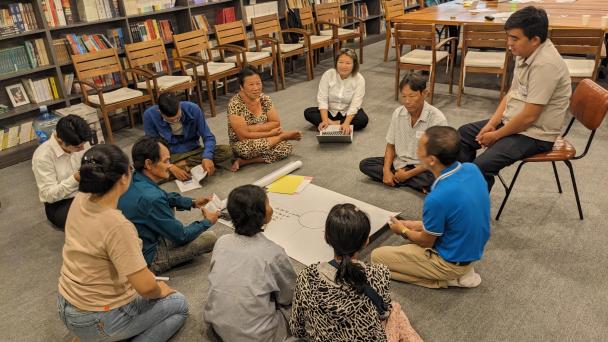New research shows no increase in the proportion of adults in England with autism or psychotic disorders
 Press release
Press release
A stark and newly developed ‘worry gap’ has opened up between women and men since the onset of the COVID-19 pandemic, new data from the National Centre for Social Research (NatCen) reveals today.
In January 2022, almost two years after the onset of the pandemic, women in Britain were twice as likely as men to report they were ‘extremely worried’ about most life areas they were asked about. There was little difference in levels of worry between women and men before the pandemic, in 2018 and 2019.
As a result of this divergence, women in Britain are now disproportionately bearing the burden of increased worries about parents, children and work-life balance:
The findings are published as part of NatCen’s annual Society Watch report, which in 2022 examines the social legacy of the COVID-19 pandemic.Researchers examined data collected via the NatCen Panel, a nationally representative sample of adults across Britain, in January 2018, January 2019 and January 2022 to explore levels of worry in Britain.
While overall levels of worry in the population were relatively stable across these dates, a large and previously unseen gap had opened between women and men by January 2022.
In January 2022, almost one in five women (18%) reported being ‘extremely worried’ about most of the life areas they were asked about in January 2022. This was twice as high as the proportion of men (9%, or almost one in ten) who were extremely worried most areas of their lives.
The divergence between parents is more stark, with mothers three times as likely as fathers to say they were extremely worried about most areas asked about in 2022 (23% and 8% respectively).
As a result of this divergence, women with children are now twice as likely as men with children to be caught between intergenerational worries about both their children and their parents.
Four out of ten women (43%) reported being extremely worried about both their parents’ and their children’s health and wellbeing in 2022, compared with two out of ten men (21%).
In January 2022, around half of women (52%) reported being extremely worried about the health and wellbeing of their parents. This was compared to only around one in three men (32%).
Similarly, most women (53%) reporting they were extremely worried about their children’s health and wellbeing, compared with around one in three men (34%).
A large minority of women were already ‘extremely worried’ about their children’s health and wellbeing in 2019, but this has grown to a majority in 2022, while the proportion of men extremely worried about their children’s health and wellbeing has remained unchanged.
In January 2019, a similar proportion of women (19%) and men (21%) said they were ‘extremely worried’ about their work-life balance.
That parity has now been lost, with the number of women extremely worried about their work-life balance increasing to 31%, or three in ten, and the numbers of concerned men remaining steady at 20%, or two in ten, in January 2022.
Similarly, women were more than three times as likely as men to report being extremely worried in January 2022 about their level of education, qualifications and training (17% compared to 5%). This gap was likewise not seen in data collected in January 2018 or January 2019.
Josefien Breedvelt, Director of Analysis at the National Centre for Social Research and co-author, said: “While overall levels of worry appear to be the same in 2022 as they were pre-pandemic, this conceals a stark ‘worry gap’ that has opened up between women and men. The pandemic increased the burden on many women who often had to deal with additional caring pressures, while many female-dominated sectors from care work to the service industry were particularly badly hit.
Women may still be experiencing a greater impact from the ongoing legacy and stress that the pandemic brought about. If ongoing challenges from the pandemic and the cost of living crisis fall disproportionately on women, we may see an even greater divergence in levels of worry between men and women in Britain.”
NatCen’s Society Watch 2022 report and the accompanying briefing paper exploring levels of worry in Britain since the pandemic will be published at 00:01am on Thursday 14 July at www.natcen.ac.uk/society-watch-2022.
For more information please contact:
Oliver Paynel, Communications Manager, National Centre for Social Research
oliver.paynel@natcen.ac.uk
Direct: 0207 549 9550
Mobile: 07734 960 071
Katie Crabb, Head of Marketing and Communications, National Centre for Social Research
katie.crabb@natcen.ac.uk
Direct: 0207 549 8504
1. The National Centre for Social Research (NatCen), Britain’s largest independent social research organisation, aims to promote a better-informed society through high quality social research (www.natcen.ac.uk).
2. This research is based on three surveys conducted via the NatCen Panel with a nationally representative sample of adults aged 18+ in Great Britain at three different time points, in January 2018 (2,199 adults), January 2019 (2,048 adults) and January 2022 (1,122 adults). Data from January 2018 and January 2019 were collected as part of Sainsbury’s Living Well index.
3. Each survey contained an identical set of questions asking respondents how much they worried about 16 different areas of life (their physical health, their mental health, their relationship with their partner or spouse, their relationship with their family, their relationship with their friends, their children’s health and wellbeing, their partner or spouse’s health and wellbeing, their parents’ health and wellbeing, their work-life balance, their education, qualifications and training, their work situation, money or debt, their housing situation, how safe they feel in their local area, their appearance (including their weight and looks) and their social life). Respondents were only asked about the areas that were relevant to them.
4. The NatCen Panel comprises people who were originally interviewed (face to face) as part of NatCen’s annual British Social Attitudes survey, and who have agreed to answer occasional follow-up surveys either online or on the phone.
 Press release
Press release



Receive a regular update, sent directly to your inbox, with a summary of our current events, research, blogs and comment.
Subscribe